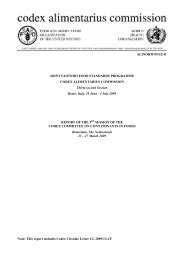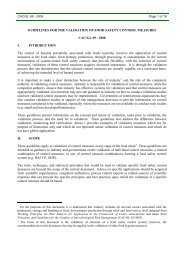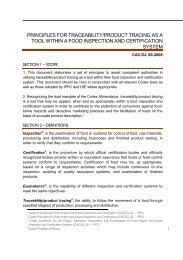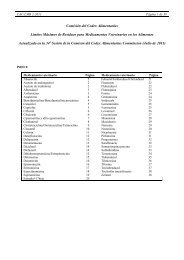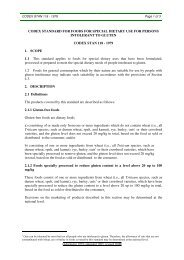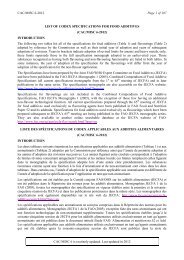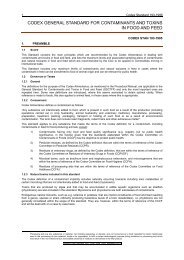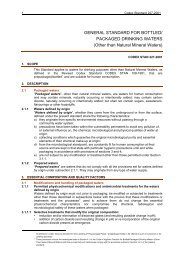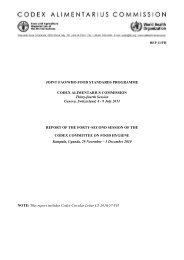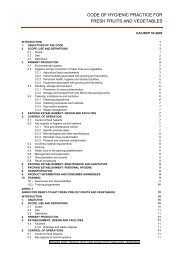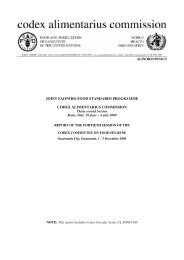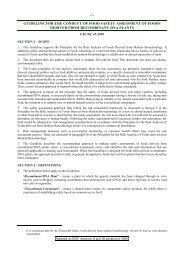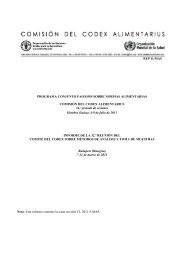General Standard for Food Additives - CODEX Alimentarius
General Standard for Food Additives - CODEX Alimentarius
General Standard for Food Additives - CODEX Alimentarius
Create successful ePaper yourself
Turn your PDF publications into a flip-book with our unique Google optimized e-Paper software.
<strong>CODEX</strong> STAN 192-1995 Page 39 of 287<br />
of the bees’ own, and store it in a honeycomb to ripen and mature. 69 Examples of honey include wildflower<br />
honey and clover honey.<br />
11.6 Table-top sweeteners, including those containing high-intensity sweeteners:<br />
Includes products that are preparations of high-intensity sweeteners (e.g., acesulfame potassium) and/or of<br />
polyols (e.g., sorbitol) which may contain other additives and/or nutritive ingredients, such as carbohydrates.<br />
These products, which are sold to the final consumer, may be in powder, solid (e.g., tablets or cubes), or<br />
liquid <strong>for</strong>m.<br />
12.0 Salts, spices, soups, sauces, salads, protein products:<br />
This is a broad category that includes substances added to food to enhance its aroma and taste (12.1 – salt<br />
and salt substitutes; 12.2 – herbs, spices, seasonings and condiments (e.g., seasoning <strong>for</strong> instant noodles);<br />
12.3 – vinegars; and 12.4 - mustards), certain prepared foods (12.5 – soups and broths; 12.6 – sauces and like<br />
products; and 12.7 – salads (e.g., macaroni salad, potato salad) and sandwich spreads, excluding cocoa- and<br />
nut-based spreads of food categories 04.2.2.5 and 05.1.3)), and products composed primarily of protein that<br />
are derived from soybeans or from other sources (e.g., milk, cereal, or vegetables) (12.9 - soybean-based<br />
seasonings and condiments; and 12.10 – protein products other than from soybeans).<br />
12.1 Salt and salt substitutes:<br />
Includes salt (12.1.1.) and salt substitutes (12.1.2) used as seasoning <strong>for</strong> food.<br />
12.1.1 Salt:<br />
Primarily food-grade sodium chloride. Includes table salt, iodized and fluoride iodized salt, and dendritic<br />
salt.<br />
12.1.2 Salt substitutes:<br />
Salt substitutes are seasonings with reduced sodium content intended to be used on food in place of salt.<br />
12.2 Herbs, spices, seasonings, and condiments (e.g., seasoning <strong>for</strong> instant noodles):<br />
This category describes items whose use is intended to enhance the aroma and taste of food.<br />
12.2.1 Herbs and spices:<br />
Herbs and spices are usually derived from botanical sources, and may be dehydrated, and either ground or<br />
whole. Examples of herbs include basil, oregano and thyme. Examples of spices include cumin and caraway<br />
seeds. Spices may also be found as blends in powder or paste <strong>for</strong>m. Examples of spice blends include chilli<br />
seasoning, chilli paste, curry paste, curry roux, and dry cures or rubs that are applied to external surfaces of<br />
meat or fish.<br />
12.2.2 Seasonings and condiments:<br />
Condiments include seasonings such as meat tenderizers, onion salt, garlic salt, Oriental seasoning mix<br />
(dashi), topping to sprinkle on rice (furikake, containing, e.g., dried seaweed flakes, sesame seeds and<br />
seasoning), and seasoning <strong>for</strong> noodles. The term “condiments” as used in the FCS does not include<br />
condiment sauces (e.g., ketchup, mayonnaise, mustard) or relishes.<br />
12.3 Vinegars:<br />
Liquid produced from fermentation of ethanol from a suitable source (e.g., wine, cider). Examples include,<br />
cider vinegar, wine vinegar, malt vinegar, spirit vinegar, grain vinegar, raisin vinegar, and fruit (wine)<br />
70<br />
vinegar.<br />
12.4 Mustards:<br />
Condiment sauce prepared from ground, often defatted mustard seed that is mixed into a slurry with water,<br />
vinegar, salt, oil and other spices and refined. Examples include Dijon mustard, and “hot” mustard (prepared<br />
71<br />
from seeds with hulls).<br />
69<br />
<strong>Food</strong> Chemistry, H.-D. Belitz & W. Grosch, Springer-Verlag, Heidelberg, 1987, p. 636. Codex <strong>Standard</strong> <strong>for</strong> Honey<br />
(<strong>CODEX</strong> STAN 12-1981).<br />
70<br />
<strong>Food</strong> Chemistry, H.-D. Belitz & W. Grosch, Springer-Verlag, Heidelberg, 1987, pp. 719-720.



